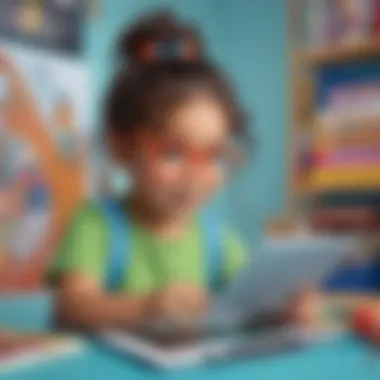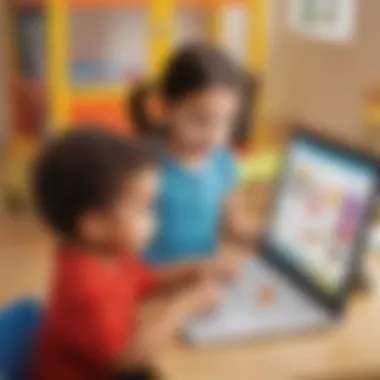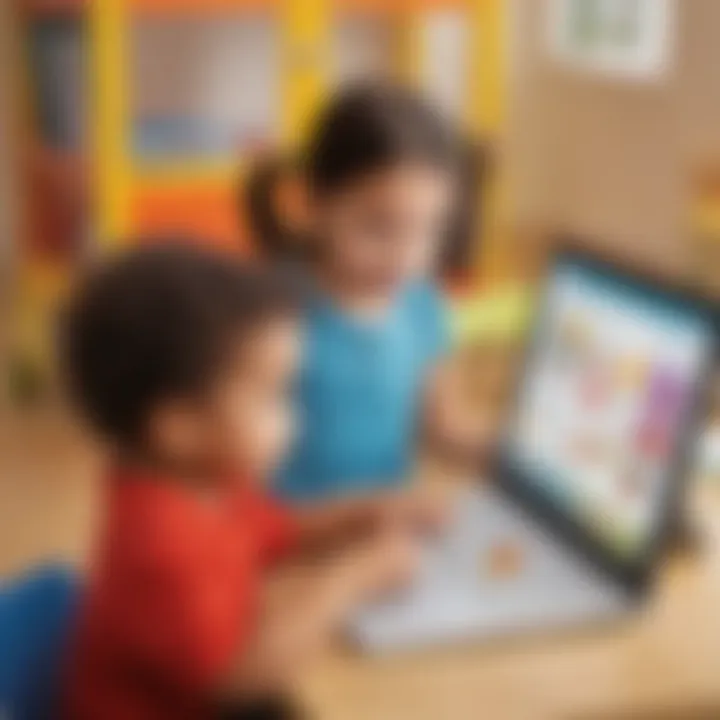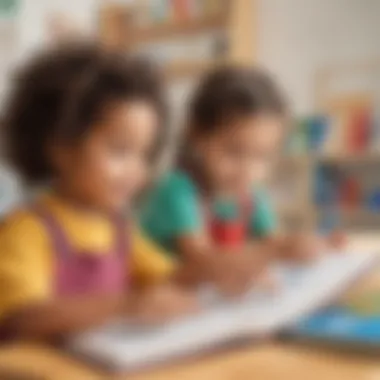Exploring Free Online Learning Resources for Preschoolers


Intro
In today’s digital age, finding the right educational resources for preschoolers has never been easier. With a multitude of free online curricula available, parents and caregivers can now access diverse teaching tools that foster early childhood learning. This guide dives into the various options out there, empowering caregivers to make educated choices regarding their children's education.
The Importance of Early Learning
The foundational years of a child's life are crucial. Research suggests that engaging in structured learning can significantly impact a child's development. By integrating free online curricula into home environments, caregivers actively contribute to building essential skills that pave the way for future academic success. Moreover, these curricula cater to varying learning styles, ensuring that each child can thrive out of their comfort zone.
Now, let’s unravel the myriad of creative activities, quizzes, and fact-based articles ripe for discovery. Each section will spotlight how these resources can be woven into your preschooler's daily routine, enhancing their learning experience.
Creative Activities
Creative activities hold untapped potential for little learners. They not only keep preschoolers entertained but also encourage them to express themselves artistically. Let’s explore some engaging craft ideas and the reasons they matter in a child's educational journey.
Craft Ideas
Crafting is like a treasure chest of experiences for kids. Every cut, fold, and paint stroke lays down a building block for skills. Here are a few craft ideas that children can easily replicate with guidance:
- Paper Plate Animals: Using paper plates, markers, and basic craft supplies, children can create their favorite animals. This activity fosters fine motor skills and encourages creativity as they decide colors and designs.
- Nature Collages: Collecting leaves, flowers, and other natural items to glue onto a paper builds environmental awareness while enhancing their creativity. A simple stroll outside can transform into a hands-on lesson!
- Rock Painting: Simple pebbles can become beautiful art. Kids can paint subjects like animals or simply whimsical designs. This activity promotes hand-eye coordination and offers a conversation starter.
Step-by-Step Guides
To fully embrace these creative activities, simple step-by-step guides can make a world of difference. For instance:
- Gather Materials: Choose age-appropriate items. Always check for safety.
- Demonstrate: Show your child how to use the materials, step by step. It’s a learning experience on both sides.
- Encourage Independence: Allow the child to explore and make choices in their craft. Little decisions are big steps.
- Discuss: Talk with them about their creations. What do they feel? What is the story behind their art? This reflection enhances communication skills.
Educational Value
Engaging in these creative projects isn't just fun; it has profound educational benefits. Craft activities promote:
- Cognitive Skills: Understanding shapes, colors, and spatial relationships.
- Motor Skills: Cutting, gluing, and painting enhance coordination.
- Social Skills: Group crafts provide opportunities for teamwork and sharing.
"Learning through play makes education enjoyable, and enjoyment leads to better retention!"
Just like that, a simple craft activity becomes a multi-faceted learning experience.
Fun Quizzes
Quizzes can be a thrilling tool for reinforcing learned concepts in a fun format. Let's examine the variety of quizzes available, especially on platforms like ElemFun, which cater to preschool education.
Quiz Topics
Quizzes often cover fundamental topics such as:
- Numbers and Counting
- Alphabet Letters
- Animals and Nature
- Colors and Shapes
These topics are designed to be age-appropriate, keeping young learners engaged.
Question Types
To keep things exciting, quizzes use a variety of question types:
- Multiple-Choice Questions: Offers a fun way to make decisions.
- Fill in the Blanks: Encourages critical thinking and retention of information.
- Match the Pictures: This helps children learn visual connections and associations.
Knowledge Reinforcement
These quizzes serve an important purpose: reinforcing knowledge. They provide immediate feedback, allowing children to understand what areas they need to work on, making learning a continuous and engaging journey.
Fact-Based Articles
As children explore the world around them, they become curious. Fact-based articles provide a window into knowledge, answering their endless questions. Let’s delve into the benefits of these informative reads.
Topics
Fact-based articles can cover a wide array of subjects, such as:
- Historical Figures
- Scientific Concepts
- Cultural Practices
- Natural Wonders
These subjects spark curiosity and provide children with a broader perspective of their environment.
Engaging Content
The best articles present information in a way that's easy to understand yet captivating. They often include bright visuals, relatable anecdotes, and simple explanations, making complex topics accessible for preschoolers. This kind of content promotes an early love for reading.
Preamble to Online Learning for Preschoolers
As the digital age continues to expand, the landscape of early childhood education has begun to shift significantly. Online learning for preschoolers offers a plethora of opportunities that were not available in traditional settings. This shift is crucial not only in keeping pace with technological advancements but also in enriching the learning experience for our little ones.
It’s important to note that preschoolers’ brains are like sponges, soaking up information and making connections at an astonishing rate. Utilizing online resources can cater to this developmental stage by providing interactive content that stimulates curiosity and engagement. Incorporating digital tools into their education can help in fostering essential skills they will carry throughout their lives.
Parents and caregivers, however, might ask themselves: "Are these online programs effective?" The answer is multi-faceted. Depending on the curriculum, many online platforms can enhance foundational skills such as language, literacy, and basic math concepts. The fun and games embedded in these resources can maintain a child’s interest, which is half the battle when it comes to education at this level.
"Online learning can make learning as easy as pie for preschoolers, engaging them in ways that books and worksheets alone often cannot."
Nevertheless, it’s essential to evaluate the quality and appropriateness of online materials. Not all resources are created equal. Some may promote passive consumption of information rather than active participation. Additionally, the screen time factor needs to be considered since experts recommend balancing digital experiences with real-world interactions.
Benefits of Online Learning for Preschoolers:
- Flexibility: Enables learning at a child's own pace, fitting into varying schedules.
- Diverse Learning Styles: Offers various formats, including videos, games, and interactive lessons, catering to different learners.
- Accessibility: Free online curricula break down geographic and economic barriers, providing equal opportunities for often underserved populations.
In short, online learning for preschoolers isn't just a passing trend; it's a significant movement in education that requires careful consideration. Parents and educators must navigate this digital terrain wisely to set the groundwork for lifelong learning. By leveraging online curricula thoughtfully, we can help children reach their full potential while preparing them for the challenges of the future.
The Need for Accessible Educational Resources
In today’s fast-paced world, young minds are often introduced to technology at an early age. For preschoolers, the right access to educational resources can make a world of difference in their cognitive and social development. The significance of accessible educational resources especially online cannot be understated. It opens doors for learning that may not be available due to geographical or socio-economic barriers.


Equal Opportunities in Learning
Many families, especially in underserved communities, find themselves struggling to provide adequate educational materials for their children. The availability of free online curricula caters to this need. It empowers caregivers and educators to give each child the opportunity to learn, regardless of their circumstances. This kinds of resources create a more level playing field, ensuring that even without the means to afford expensive learning materials, every preschooler can still embark on a learning journey.
"Knowledge is power, but accessibility to that knowledge is the key that unlocks the door."
Early Exposure to Learning
When children engage with educational content early in life, they develop foundational skills that will serve them throughout their academic careers. Online curricula often offer interactive and engaging methods of teaching, making concepts easier to grasp. Resources like simple videos, engaging games, and colorful animations have a way of capturing a child’s attention, making learning enjoyable rather than chore-like. This early exposure lays the groundwork for lifelong learning habits.
Flexibility and Customization
The beauty of accessible online curricula lies in its flexibility. Caregivers can choose resources that align with their children’s interests or specific learning needs, whether it’s a love for animals or a curiosity about numbers. Parents can tailor learning experiences based on their child’s pace, allowing them to master skills before moving on to new concepts, which can help avoid frustration often associated with traditional learning methods.
- Supports personalized learning:
- Tailors resources to fit individual child needs.
- Encourages children to explore their passion areas.
Diverse Learning Styles
Every child is unique and learns in their own way. Accessible educational resources offer a range of formats that cater to various learning styles. Visual learners benefit from videos and illustrations, while auditory learners thrive with podcasts and reading aloud. Kinesthetic learners, on the other hand, find joy in interactive games that involve movement and hands-on activities. By providing an assortment of options, these resources allow for a richer, more inclusive educational experience.
Fostering Parent Engagement
Finally, free online curricula often encourage parents to be more involved in their child's learning process. Most platforms provide guides and ideas on how to extend the learning experience beyond the digital realm. This partnership between parents and children can strengthen their bond while ensuring that learning becomes a family activity. When parents engage with their children in learning, they build confidence and curiosity that is invaluable for a child’s development.
In summary, the need for accessible educational resources cannot be ignored in our modern landscape. These online tools are not just alternatives; they are essential for nurturing educated, well-rounded individuals. By harnessing these resources, we can ensure that every child, irrespective of their background, has the ability to thrive and flourish.
Exploring Different Types of Online Curricula
When it comes to teaching preschoolers, the landscape of available online curricula is vast and varied. Understanding the different types of online curricula is paramount for parents and educators looking to provide optimal learning experiences. This exploration not only aids in recognizing quality resources but also allows caregivers to tailor educational content to their child's specific needs and learning style.
In the digital age, education is no longer confined to the walls of a classroom. Instead, children can engage with their learning through structured programs as well as dynamic, informal resources. Each type of curriculum offers its own set of advantages and considerations, shaping the educational journey of young learners. By dissecting these types, parents can make informed decisions that foster a love for learning and support developmental milestones.
Structured Programs vs. Informal Learning
Structured programs are like blueprints for learning, providing a clear path that aligns with educational standards. These programs usually come with defined curricula, lesson plans, and assessment tools. They often cover essential subjects such as literacy, math, and science methodically, which reassures parents who seek a more traditional approach to education. High-quality structured resources often include elements like daily schedules and consistent progress tracking, making it easier for parents to monitor their child’s development.
On the flip side, informal learning harnesses the power of exploration and curiosity. This approach often employs a more relaxed style, allowing children to learn through play, social interactions, and creative activities. Think of it as a treasure hunt where young learners set their own course. Informal resources can include interactive videos, educational apps, and even hands-on science experiments at home. These methods often celebrate spontaneity and creativity, engaging children in a way that feels less like learning and more like fun.
Both structured and informal learning have value, but determining which suits a child's needs might depend on their personality or specific learning objectives. One can argue that a blend of both—a structured framework paired with room for informal exploration—could be the key to a balanced educational experience.
Interactive Games and Activities
Incorporating interactive games and activities into online curricula has become a game-changer in early childhood education. The engaging nature of these tools captures children's attention and motivates them to participate. These resources range from digital puzzles reinforcing shapes and numbers to storytelling apps that spark imagination and language development.
Interactive activities often cater to various learning styles. Some kids may thrive in a visual environment, while others find auditory or kinesthetic methods more engaging. Here are a few compelling reasons to consider interactive games:
- Enhanced Engagement: Kids are naturally drawn to games. When learning is presented in a fun, game-like format, they are more likely to participate eagerly, which can lead to better retention of information.
- Immediate Feedback: Many online platforms provide instant responses to a child's actions. This immediate feedback loop, whether it’s through a reward system or tips for improvement, can be crucial for developing confidence and curiosity.
- Promotes Critical Thinking: Many interactive games are designed to challenge players, allowing children to solve problems and think critically. For example, a math game may require children to strategize about the best way to reach a solution.
Popular Free Online Platforms
The digital age has opened up a treasure trove of resources for preschool education, making it easier than ever for parents and educators to access quality materials without breaking the bank. Popular free online platforms come into play here, serving as vital tools that can enrich the early learning experience for children. These platforms not only provide engaging content but also cater to various learning styles, ensuring that every child has the chance to thrive.
It's important to understand that not all platforms are equal in quality or approach. Some offer structured learning paths while others allow for more casual exploration. When selecting a platform, consider the following:
- Content Quality: Is the material age-appropriate?
- User Experience: Is it easy to navigate, both for children and adults?
- Engagement: Does it keep children interested without being overstimulating?
Choosing the right platform not only keeps kids engaged but also sets the stage for a love for learning that can extend into their formal education.
Open Educational Resources (OER)
Open Educational Resources (OER) stand out as powerful tools available for preschool education. They are learning materials freely accessible online that meet various educational needs. The beauty of OER is that they come in different forms — from textbooks to videos and even interactive exercises.
A few benefits include:
- Diversity in Content: Parents can choose from a wide range of subjects and approaches, tailoring the experience according to their child's interests and needs.
- Collaborative Learning: These resources often allow for community contributions, meaning that new and innovative materials are constantly being developed and shared.
- Cost-Effective: Families don't have to spend a dime, yet they gain access to high-quality educational content.
Educational Websites and Blogs
There are countless educational websites and blogs aimed at preschoolers, each one offering unique insights and resources. These sites can act as digital compendiums of learning activities, providing articles, lesson plans, and printable worksheets. Parents looking for enriching, hands-on experiences will find these resources invaluable.
When evaluating educational websites, keep these factors in mind:
- Reputation: Is the website known for credible information?
- User Reviews: Checking feedback from other users can help gauge effectiveness and suitability for your child.
- Variety of Learning Methods: Websites that incorporate storytelling, games, and practical activities allow children to learn through play.
Some well-known sites include PBS Kids and Starfall, which offer interactive content that makes learning feel more like a game than a chore.
YouTube Channels for Preschool Learning
YouTube can serve as an excellent resource for preschool education, with a bounty of channels dedicated to early learning. The platform hosts numerous creators who focus purely on educating young minds through animated stories, songs, and interactive lessons.
Benefits of utilizing YouTube include:
- Visual Learning: The audiovisual format can cater to various types of learners, making complex concepts more understandable.
- Incremental Learning: Channels often break down lessons into bite-sized segments, allowing children to absorb information more effectively.
- Global Reach: Parents can find content from different cultures, which can provide a well-rounded educational experience.
Channels like Cosmic Kids Yoga and The Singing Walrus not only entertain but also engage children in a meaningful way.
In summary, leveraging popular free online platforms such as OER, educational websites, and YouTube channels can immensely enrich the preschool learning experience. Selecting the right resources can help foster curiosity and a genuine love for learning in young minds.
Curriculum Components to Consider
When it comes to selecting online curricula for preschoolers, it is essential to focus on the specific components that contribute to a well-rounded learning experience. Each element plays a unique role in cultivating not only academic skills but also social and emotional growth. The effectiveness of a curriculum hinges on how well these components are integrated, ensuring that young learners are engaged and developing holistically.
Language Development and Literacy Skills
Language development is the bedrock for communication and comprehension in early childhood education. It’s not just about learning the alphabet; it encompasses phonemic awareness, vocabulary development, and the enjoyment of stories. Digital resources that emphasize storytelling can help children explore new worlds, characters, themes, and, crucially, new words.


Advantages of Focusing on Language Skills:
- Increases vocabulary
- Enhances listening skills
- Promotes critical thinking through varied narratives
Many platforms offer interactive reading sessions, where kids can hear stories and participate by repeating phrases or answering simple questions. This real-time engagement mirrors the interaction they would have in a traditional classroom, making grasping complex concepts much simpler. For example, websites like Starfall provide both visual and auditory cues, which aid in the retention of information.
Mathematics and Problem-Solving
Math is often seen as a daunting subject, but preschool curricula can make it more approachable through playful learning. Introducing concepts such as numbers, shapes, and patterns through games and interactive activities encourages exploration and curiosity.
Key Elements of Early Math Learning:
- Counting through songs or games
- Recognizing patterns through movement and art
- Basic addition and subtraction with visual aids
Platforms like PBS Kids include programs that take children on fun adventures, where they need to solve puzzles using math principles. Such methodologies help instill a love for math by showing kids the practical applications in everyday situations, making it less abstract and more tangible.
Science and Exploration
Scientific literacy begins with exploration. For preschoolers, this can mean observing the world around them and asking questions about nature, the environment, and basic physics concepts. Engaging children in science helps build critical thinking and encourages them to observe phenomena, make predictions, and test hypotheses.
Benefits of Science in Early Education:
- Sparks curiosity about the natural world
- Fosters problem-solving skills
- Encourages hands-on activities and experimentation
Websites like NASA’s Space Place strip down complex concepts to child-friendly language, allowing kids to learn about space and Earth science visually and interactively. This makes science not only accessible but also fun.
Social-Emotional Learning
While academic skills are crucial, social-emotional development is equally important. It encompasses understanding emotions, building relationships, and developing empathy. Integrating social-emotional learning into online curricula prepares children to navigate their feelings and the feelings of those around them.
Aspects of Social-Emotional Learning:
- Recognizing and expressing feelings
- Building friendships
- Understanding consequences of actions
Platforms like Sesame Street provide valuable lessons on emotions and social interaction through character-driven stories and relatable scenarios. This helps kids learn to articulate their feelings, paving the way for healthier interactions and support systems in their everyday life.
"A well-rounded education is defined not just by academic success, but also by emotional growth and the ability to connect with others."
Evaluating Quality and Effectiveness
Evaluating the quality and effectiveness of online curricula for preschoolers is not just a mere checklist task, it’s a crucial step in ensuring that children get the best educational resources available. In a world where the internet is saturated with information, distinguishing the wheat from the chaff can be quite a challenge. This section delves into why evaluation matters and what factors you should consider when pondering over various online learning options for your little learners.
Criteria for High-Quality Curricula
When searching for online curricula, a few key criteria can help determine the quality:
- Educational Value: Look for content that aligns with early childhood education standards. Programs should cover essential skills like language, math, and social-emotional development and present them in an age-appropriate manner.
- User Engagement: The best curricula are those that engage young learners. Interactive elements like quizzes, games, and videos can capture their attention and make learning enjoyable.
- Developmentally Appropriate Practices: Activities should cater to the developmental stages of preschoolers. Content that is too complex can hinder understanding, while overly simple material may lead to boredom.
- Accessibility: Resources should be easily accessible on various devices. A platform that functions seamlessly on tablets, smartphones, and computers makes it easier for kids to learn wherever they are.
- Support for Diverse Learning Styles: Quality curricula consider different learning preferences by incorporating visual, auditory, and kinesthetic activities. This ensures all children, regardless of their learning methods, can benefit.
- Regular Updates: Continually evolving content means that the program stays relevant. Platforms that provide fresh resources regularly indicate a commitment to ongoing educational quality.
- Parent and Educator Guidance: It’s beneficial if the program offers support materials for caregivers and teachers. Guidance on how to use the curriculum effectively can make a significant difference in how well the content is understood and retained.
User Reviews and Testimonials
User experiences can often provide unique insights into a program’s effectiveness. Reading reviews and testimonials from parents and educators can help assess if a curriculum is truly meeting the needs of its young users. Here are some important aspects to consider:
- Authenticity of Feedback: Look for genuine reviews that detail specific experiences. Don't just settle for star ratings; delve deeper into what users liked or disliked about the curriculum.
- Diverse Perspectives: Seek out testimonials from a range of users. Feedback from parents, teachers, and even children will give you a fuller picture of how effective the resource really is.
- Outcomes and Results: Pay attention to comments regarding the learning outcomes. Did children improve their skills in particular areas? Were there noticeable changes in engagement or interest in learning?
- Community Insights: Engaging with others in online forums or social media groups can provide even more perspectives. Websites like reddit.com and facebook.com often have discussions or threads on educational resources where you can glean useful information.
"Evaluating curricula quality is like choosing a vehicle for a long journey; you want one that won’t break down halfway!"
Setting Up a Learning Environment at Home
Creating an effective learning environment at home is an essential step in maximizing the benefits of free online curricula for preschoolers. This process isn’t just about putting a tablet on the table. It’s about establishing a space that encourages exploration, creativity, and engagement. By setting up a conducive atmosphere, caregivers can ensure that children not only engage with digital content but also thrive in their learning experiences.
One of the most significant advantages of designing a well-thought-out learning space is that it nurtures a child’s focus and enthusiasm. Kids often have a shorter attention span. A cluttered or distracting area can lead to daydreaming and disinterest in the educational materials. When kids have a dedicated area that’s neat and equipped specifically for learning, it promotes a sense of purpose and readiness to absorb new concepts.
Designing a Kid-Friendly Space
The design of this learning space matters a lot. It should be safe, inviting, and tailored to the child's age and interests. Here are some key pointers:
- Select the Right Location: Choose a quiet room or corner away from distractions like televisions or noisy siblings. An established area signals to children that it’s time to focus on learning.
- Furniture Matters: Use child-sized furniture. A small table and chair set can create a comfortable learning environment. Ensure the chair is at the right height so that the child can sit comfortably while engaging with their materials.
- Create an Interactive Wall: Consider dedicating a wall to incorporate tools that stimulate learning, such as colorful charts, a calendar, or a whiteboard. This adds a visual element to the learning space and invites kids to interact with their environment.
- Organize Supplies: Keep educational materials like books, coloring supplies, and learning games within easy reach. An organized space helps children know where to find what they need, which fosters independence.
- Incorporate Comfort Elements: A cushion or a small rug can create a cozy corner for reading or quiet time. Having comfortable elements allows children to settle in and often makes them more willing to engage with content.
"A well-designed space is not just about aesthetics; it’s about fostering an environment where learning can unfold naturally."
Incorporating Technology Safely
As we dive into technology, it’s vital to address its role in a preschooler's learning environment. Technology can be a slippery slope. While beneficial, it must be integrated cautiously and thoughtfully. Here are some essential considerations:
- Screen Time Management: Establish clear rules regarding how much time children can spend online. The American Academy of Pediatrics recommends no more than one hour per day of high-quality programming for kids aged 2 to 5. By having time limits in place, children develop a balanced relationship with technology.
- Choosing Appropriate Content: Ensure that the online resources and games chosen are age-appropriate and aligned with developmental goals. Not everything labeled as "educational" truly offers value.
- Co-Viewing Experience: Whenever possible, engage with children during their online learning. Ask questions, watch tutorials together, or play educational games side by side. This not only enhances understanding but also allows for discussions about what they learn.
- Cyber Safety: Teach children about online safety. Discuss which online behaviors are acceptable, such as not sharing personal information and recognizing trustworthy sources.
- Encourage Breaks: Integrate off-screen activities to combat fatigue from lengthy periods of technology use. Whether it's stretching, puzzles, or simple crafts, such activities complement digital learning, ensuring children stay engaged without feeling overwhelmed.
Creating a learning environment is a continuously evolving process. Every child is unique, and what works for one might not work for another. Observing how children interact with their space and materials is key to making thoughtful adjustments. With a tailored approach, caregivers can help children harness the power of online curricula effectively.
Engaging Young Learners
Engaging preschoolers in their learning journey is a fundamental aspect of effective early childhood education. When they are involved and interested, children are more likely to absorb information and develop essential skills. It's not just about keeping them occupied with digital resources; it’s about actively involving them in the learning process. This section delves into methods that keep children engaged, ensuring they are not merely passive recipients of information but active participants in their own education.
Strategies for Keeping Attention
Children in their preschool years often have shorter attention spans. Thus, it’s key to employ strategies that capture their fleeting focus. Here are some effective strategies:
- Interactive Learning: Use platforms that encourage participation. Activities that require children to click, drag, or answer questions actively involve them.
- Variety of Content: Switch things up. Include videos, songs, stories, and games. This keeps the learning experience fresh and exciting.
- Timed Challenges: Introducing time-limited tasks can create urgency and excitement. Completing a short game or quiz before a timer runs out can spark enthusiasm.
- Fun Rewards: Digital badges or simple rewards can motivate children to engage further. This feature can reinforce their progress and keep their spirits high.
- Real-Life Connections: Relate lessons to daily activities. If the lesson involves counting, involve snack time, tapping into familiar experiences.
"A child’s curiosity is the compass that guides their learning path."
Implementing these strategies helps foster a sense of curiosity and motivation, equipping children with the desire to learn through engaging, fun formats.
Adapting Curricula to Individual Needs
No two children are alike. Each has their own pace of learning, interests, and strengths. Customizing learning experiences is not just beneficial but necessary in early education. Here’s how to adapt curricula effectively:


- Personalized Learning: Platforms offer various levels of difficulty for activities. Allowing children to choose what and how they learn empowers them.
- Observational Assessment: Take note of what captivates your child. If they gravitate more toward stories, consider story-based learning modules that facilitate literacy skills.
- Variety of Representation: Use different mediums and methods to teach the same lesson. This could be through videos, flashcards, or hands-on activities, considering how your child best connects with different types of information.
- Feedback Loops: Encourage feedback through simple conversations. Ask what they enjoyed or didn’t like about a lesson. This not only promotes communication but also helps assess what changes need to be made.
- Flexible Pacing: Allow the children to advance at their own pace, providing them grace if they need to revisit concepts. Letting them lead their educational journey fosters confidence in their own abilities.
Adapting learning experiences to align with individual needs is more than catering to preferences; it’s about fostering a positive association with education that could last a lifetime.
Balancing Screen Time and Hands-On Learning
In today's digital age, the integration of technology into early childhood education has become both a blessing and a curse. While online curricula offer engaging resources for preschoolers, it is crucial for parents to strike a balance between screen time and hands-on experiences. The early years of a child's life are vital for cognitive, emotional, and physical development, and how parents approach this balance can greatly influence learning outcomes.
Benefits of Balancing
Finding that sweet spot between digital interaction and physical activities can yield numerous benefits.
- Cognitive Skills: Screen time can enhance learning through interactive lessons, leading to improved recognition of letters and numbers. However, engaging in hands-on activities fosters better problem-solving skills.
- Physical Development: Movement is essential for children. While screens offer intellectual stimulation, playing with blocks or engaging in arts and crafts helps develop motor skills essential for everyday tasks.
- Social Interaction: Screen-based learning often lacks the social elements of face-to-face interaction. Activities like group plays or collaborative games teach children about cooperation and teamwork.
Considerations About Balancing
Despite the advantages, there are important factors parents should keep an eye on:
- Age Appropriateness: Not all online content is suitable for preschoolers. Ensure that the selected resources cater to their development.
- Quality of Screen Time: Select educational games or teaching videos that are engaging yet informative. Avoid content that is overly stimulating or distracting.
- Parental Involvement: Actively participating in both screen time and hands-on activities can provide valuable bonding opportunities and guide children in using resources effectively.
Establishing Effective Time Limits
Setting boundaries is key to managing screen time for preschoolers. Children often get so engrossed in learning apps or videos that they lose track of time. Here are a few strategies to keep in mind:
- Routine Scheduling: Establish daily or weekly schedules that allocate specific times for digital learning and hands-on experiences.
- Use Timers: A simple timer can help children understand when their screen time begins and ends. This tool can promote self-regulation as children learn to manage their time.
- Incorporate Breaks: After a set period of screen use, encourage short breaks for movement or other activities to recharge their focus.
Integrating Physical Activities
Alongside screen-based learning, physical activities play an essential role in preschool education. Integrating these experiences doesn't have to be complicated or time-consuming. Here are some simple yet effective ideas:
- Gardening Together: Planting seeds and watching them grow reinforces scientific concepts while providing hands-on learning.
- Creative Arts and Crafts: Using materials like paper, clay, or even recycled items can stimulate creativity and encourage problem-solving.
- Simple Science Experiments: Basic experiments, such as mixing vinegar and baking soda to create a mini volcano, engage children’s curiosity while integrating science.
"Learning is rooted in real experiences. By ensuring children engage in both screen time and physical activities, we set the stage for holistic development."
Creating a symbiotic relationship between digital tools and physical engagement will not only boost a child's learning experience but also help them develop essential life skills. By being intentional with screen time and creating enriching hands-on opportunities, parents can cultivate an environment that nurtures both cognitive and physical development.
Transitioning from Online to Offline Learning
In an age where screens are ubiquitous, transitioning from online engagement to offline activities is a crucial aspect of early childhood education. This bridge between the virtual realm and reality fosters a holistic learning environment for preschoolers. The balance between these two learning mediums is what helps create a well-rounded educational experience.
Online learning has its undeniable perks. It offers accessibility to content that often caters to various developmental stages, allowing young learners to explore subjects at their own pace. However, if taken to extremes, it could lead to excessive screen time, which is often detrimental to young kids. Thus, the importance of integrating offline activities becomes clear as day.
Specific Elements to Consider
When planning for a successful transition from online to offline learning, parents and educators should consider the following elements:
- Complementary Activities: One can employ interactive crafts, outdoor explorations, or even simple science experiments that align with online lessons. For instance, if a child learns about plants online, going out to plant seeds or observing different types of leaves outdoors brings the lesson full circle.
- Educational Play: Utilizing toys that align with online curriculums enhances the learning experiences. Building blocks, puzzles, and role-playing games inspire imagination while reinforcing what was previously learned.
- Consistent Routines: Creating a routine that includes both online usage and offline activities helps maintain focus. Allocating specific times for online learning followed by physical activities provides structure. It's like winding down after a hectic day.
Benefits of Transitioning
The benefits of effectively transitioning from online to offline learning are numerous:
- Enhances Comprehension: When children engage in offline activities that reinforce online concepts, their understanding deepens. It's easier to remember what was learned when they can physically relate to it.
- Boosts Social Skills: Offline activities often involve collaboration with peers or family, helping children develop vital social skills. Building blocks with a sibling or playing a game with friends promotes teamwork and communication.
- Physical Development: Involving physical play combats the sedentary lifestyle that can creep in with too much screen time. Activities like running, jumping, or dancing contribute to developing motor skills and overall health.
"Bridging online lessons with tactile experiences creates pathways for long-lasting knowledge in young minds."
Considerations
While making this transition, there are a few things to keep in mind:
- Monitor Screen Time: Screen time shouldn’t replace human interaction. Following guidelines on how much screen time is appropriate for preschoolers can guide this balance.
- Tailor to Interests: Pay attention to what captivates the child. Not every online lesson will be a hit, and finding activities that resonate can ensure engagement.
- Feedback Loop: Encourage feedback from children about their learning experiences. Letting them express what they enjoyed or what was challenging can provide crucial insights into improving the educational journey.
The End
The transition from online to offline learning isn’t simply a shift; it’s an essential process that equips preschoolers with the tools to thrive in both educational landscapes. By recognizing the importance of this balance, parents and educators can create a nurturing environment rich in learning and development. As they navigate this journey, children can grow into curious, active learners ready for the world ahead.
Future Trends in Preschool Education Online
The landscape of preschool education is on the brink of a transformation driven by the digital age. In this section, we’ll delve into future trends that are shaping online curricula for preschoolers. Embracing these trends is essential for parents and educators who want to provide enriching learning experiences for young learners in an ever-evolving educational environment.
The shift towards online education for preschoolers not only caters to diverse learning styles but also leverages technology to enhance engagement and accessibility. Here are some important trends to consider:
- Personalized Learning Paths: This means creating customized educational experiences for each child. Algorithms can analyze a child’s progress and preferences, enabling platforms to tailor content according to their individual needs. This personalized approach can boost confidence and foster a love for learning.
- Data-Driven Insights: Educators can use data collected from children’s interactions with online tools to understand strengths and areas for improvement. This insight may prove crucial for early interventions that can significantly impact a child's educational trajectory.
- Engagement with Real-World Skills: Curricula are increasingly incorporating life skills alongside traditional lessons. STEM (Science, Technology, Engineering, and Mathematics) subjects, along with social-emotional learning, become crucial in an effort to prepare preschoolers for a more complex future.
"Education is not the filling of a pail, but the lighting of a fire." - William Butler Yeats
Control over the educational environment will likely remain central to these trends. Parents should be proactive in fostering an atmosphere where technology complements rather than replaces traditional interactions and explorations.
The Role of Artificial Intelligence
With the rise of artificial intelligence (AI), the online preschool education experience is set for remarkable advancements. AI can analyze interactions in real-time, adjusting lessons based on the child’s engagement and comprehension level. By providing immediate feedback and responses, AI can significantly enhance the learning experience. Some specific aspects include:
- Adaptive Learning: AI-powered platforms can curate lessons dynamically, moving away from a one-size-fits-all model and catering to children’s unique learning journeys.
- Interactive Learning Environments: Virtual assistants and chatbots can answer questions and encourage children to explore topics, creating engaging dialogue and critical thinking opportunities.
As AI continues to evolve, it will undoubtedly play a pivotal role in enriching preschool curricula, making learning more intuitive and aligned with each child's pace.
Evolving Educational Technologies
The tech landscape is continuously changing, bringing forth new tools that support preschool learning. As we look ahead, several technologies stand out:
- Augmented Reality (AR): Imagine children using devices that blend the digital and physical worlds. AR can create interactive experiences, allowing children to, for example, explore outer space or the deep sea from their living rooms.
- Virtual Reality (VR): VR can transport young learners into new environments, enhancing engagement in subjects like history or science in a way that books simply cannot. This immersive experience stimulates curiosity and imagination.
- Mobile Learning Apps: The widespread use of tablets and smartphones facilitates learning on the go. These apps often gamify learning, making it both fun and educational, helping to reinforce skills learned in structured settings.
End
In wrapping up, the significance of this guide lies in how it brings clarity to navigating free online curricula for preschoolers. With the ever-growing digital educational resources available, parents and caregivers face a landscape that can sometimes feel overwhelming. It’s crucial to sift through these options, identifying what truly resonates not just with their educational goals, but also with the interests and needs of their little ones.
A few key elements stand out in this exploration:
- Accessibility: Parents can tap into a variety of free resources, which may help level the educational playing field. In children’s formative years, having equal access to learning tools is pivotal.
- Versatility of Learning Approaches: The guide highlights a range of pedagogical styles. From structured programs to interactive games, there is something for every young learner’s preference. This speaks to the ability of online resources to cater to different learning styles and adapt activities based on a child's engagement or interest level.
- Integration of Technology: By discussing how to safely incorporate technology at home, caregivers can feel confident blending screen time with hands-on activities. Achieving balance is key in developing comprehensive educational experiences.
"It’s not just about filling minds with knowledge; it’s about nurturing a love for learning."
Moreover, evaluating the quality and effectiveness of online curricula is essential. Knowing what criteria to apply allows caregivers to make informed decisions that align with their educational expectations. The guide encourages thoughtful consideration of various factors such as user reviews, age-appropriateness, and content relevance.
Ultimately, this article serves as a roadmap for parents and educators. It seeks to empower them to take proactive steps in their children’s learning journeys. By leveraging the abundance of available online curricula, they can offer enriched educational experiences that cultivate curiosity and foundational skills critical for lifelong learning.
As digital education continues to evolve, staying informed about the trends and tools at their disposal will only enhance the home learning environment. The journey of educating preschoolers is a partnership, and with the right resources, it can be both fulfilling and effective.







